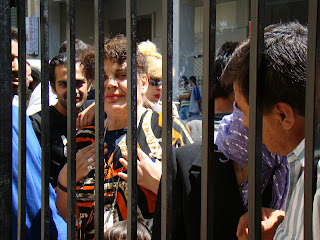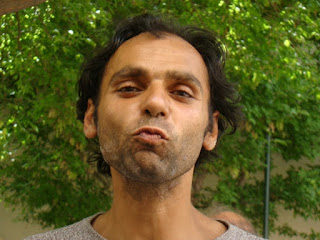Detail from Carpaccio, Triumph of St. George.
Bartolomeo Minio twice had to negotiate the dividing line between Argos and Nauplion territories with the Ottomans. The first was in August 1480, to fulfill the terms of the peace settlement between Venice and Mehmed II. The second was in April 1482, because Mehmed had died and all agreements had to be renegotiated with Beyazid II.
This 1480 commission was the first territorial definition in a very long time, certainly since 1460 and the period of the despots when borders between the despotate and Venetian territories had been extremely porous. At Methoni-Koroni, the lands of several Italians who had fiefs over the borders -- Marin Sisani, Nicoli Romagni, the Ca' Gezzo family, and Jacopo Testa -- had been included in the Venetian limits because they had given gifts to the Ottoman negotiators. At Nauplion, Minio reported giving the lead negotiator, Sinan Bey, 30-40 ducats as a gift to ensure things went well, as well as providing the housing expenses for him and his suite. In fact, between gifts and expenses, Minio paid out 100 ducats before they ever got to the negotiations He was going to collect a quarter of that from the citizens, but he was concerned about the burden it would be for them.
In 1482, Minio wrote, after the territorial agreement had been written out, the sultan's slave (who had accompanied the emin who conducted the negotiations) refused to hand it over until he had received a present, which amounted to 30 ducats and 6 braccie ("arms") of scarlet cloth for a robe. Minio gave the emin 40 ducats, and 6 braccie of scarlet. The scrivan who wrote up the agreement (and who had been most generous) got 10 ducats, the emin's three servants 5 each, and the translator 2, for a total of 97 ducats. This did not include the cost of the cloth, or the candy, or the expenses for food. The governor at Methoni wrote Minio that they had spent a total of 300 ducats on various gifts that year.
Certain Naupliots got more benefits out of the boundary settlements than others: the holders of the castelli at Castri (a Palaiologos) and Thermissi (including the bishop), and the mills of Kiveri/Myloi. Then there was the land held by the church of the bishop, and assorted other less important fiefs. Minio decided to prorate a good share of the expenses for gifts according to how much each of these had profited. Things must have improved for the fiefholders considerably in the past two years, after the first definitions of boundaries, as Minio did not this time seem concerned about burdening them.
No one thought these diplomatic expenses at all unusual. Minio wrote in other letters about making gifts of wine, fish, sugar, bread, honey, candles, white cloth, and silver cups to various Ottoman officials, and told of being given camels' hair cloth and a blue sash. These were more the sort of gifts exchanged between visitors or neighbors, and it is interesting that he is in the position of providing basic goods, as well as small luxury gifts.
Read and download the letters of Bartolomeo Minio from Nauplion.
http://www.nauplion.net/MINIO.html
This 1480 commission was the first territorial definition in a very long time, certainly since 1460 and the period of the despots when borders between the despotate and Venetian territories had been extremely porous. At Methoni-Koroni, the lands of several Italians who had fiefs over the borders -- Marin Sisani, Nicoli Romagni, the Ca' Gezzo family, and Jacopo Testa -- had been included in the Venetian limits because they had given gifts to the Ottoman negotiators. At Nauplion, Minio reported giving the lead negotiator, Sinan Bey, 30-40 ducats as a gift to ensure things went well, as well as providing the housing expenses for him and his suite. In fact, between gifts and expenses, Minio paid out 100 ducats before they ever got to the negotiations He was going to collect a quarter of that from the citizens, but he was concerned about the burden it would be for them.
In 1482, Minio wrote, after the territorial agreement had been written out, the sultan's slave (who had accompanied the emin who conducted the negotiations) refused to hand it over until he had received a present, which amounted to 30 ducats and 6 braccie ("arms") of scarlet cloth for a robe. Minio gave the emin 40 ducats, and 6 braccie of scarlet. The scrivan who wrote up the agreement (and who had been most generous) got 10 ducats, the emin's three servants 5 each, and the translator 2, for a total of 97 ducats. This did not include the cost of the cloth, or the candy, or the expenses for food. The governor at Methoni wrote Minio that they had spent a total of 300 ducats on various gifts that year.
Certain Naupliots got more benefits out of the boundary settlements than others: the holders of the castelli at Castri (a Palaiologos) and Thermissi (including the bishop), and the mills of Kiveri/Myloi. Then there was the land held by the church of the bishop, and assorted other less important fiefs. Minio decided to prorate a good share of the expenses for gifts according to how much each of these had profited. Things must have improved for the fiefholders considerably in the past two years, after the first definitions of boundaries, as Minio did not this time seem concerned about burdening them.
No one thought these diplomatic expenses at all unusual. Minio wrote in other letters about making gifts of wine, fish, sugar, bread, honey, candles, white cloth, and silver cups to various Ottoman officials, and told of being given camels' hair cloth and a blue sash. These were more the sort of gifts exchanged between visitors or neighbors, and it is interesting that he is in the position of providing basic goods, as well as small luxury gifts.
Read and download the letters of Bartolomeo Minio from Nauplion.
http://www.nauplion.net/MINIO.html






















